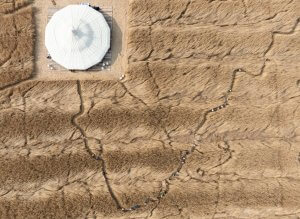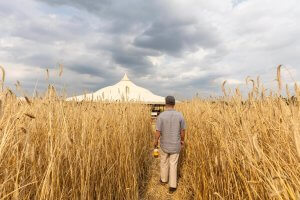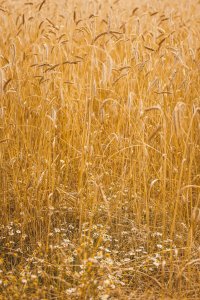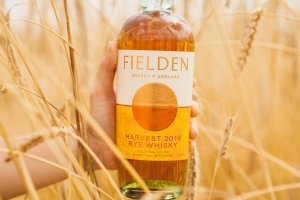A Field(en) in England (or dancing at Lughnasa)

There was an absence of fire which I must confess saddened me. What’s a pagan celebration without a blazing, eh? No games of strength either, a sacrificial bull, or a wicker man, though this might have been pushing thing a tad too far.
We’re standing in a field in the Cotswolds at the mid point between the summer solstice and the autumn equinox. It’s Lammas Day, that ancient Christian festival whose name comes from the old-English ‘hlafmæsse’ (loaf mass) where the first loaf of bread from that year’s harvest would be brought to church to be blessed.
In Ireland and much of Scotland it’ called Lughnasa, named after the trickster god Lugh who started the festival to honour his foster mother Tailtiu who died, spent, after her exertions clearing Ireland making it fit for agriculture to begin. No church here – but fiery wheel and games. (This is the extra stuff you don’t pay for folks).
The start of the harvest, the felling of John Barleycorn and giving thanks for his sacrifice. A cycle ending and getting ready to begin once more. The circularity of the year.
The evening was humid. Purple clouds massing, the fields filed with bisque/sand grain. We wandered along a winding, trampled path through the head-high crops. Flickers of the wicker man in the mind.

‘Whisky is made in the field’, or its variants ‘grain to glass’, ‘field to lips’, ‘seed to still’, ‘crop to crop’, are lines trotted out by an increasing number of distillers. Mostly, the claims are true and are a worthy recognition of whisky as an agricultural product and how the relationship between farmer and distiller is being reinvigorated. Another circle closed.
What lies behind this is the understanding that barley (or any other grain) isn’t simply a package of starch which can be turned into X00 litres of alcohol, but can be a vital contributor to flavour.
So now there’s bere, Chevallier, Annat, Maris Otter, Plumage Archer barleys. Heritage rye is being grown in the US. Older corn varieties such as Jimmy Red, Bloody Butcher, Boone County White and Japonica are being grown across the US. In Mexico, whisky distillers are replicating what their mezcal-making colleagues have done with agave varieties by exploring different types of corn. It’s now a global movement saying that grains should be thought of in the same way as grape varieties. Just imagine if every wine was made from Pinot Grigio…
It’s also a rejection of the commodity system which prizes yield over flavour or nutrition. Under that regime, the only way in which farmers can continue to increase yields is by also increasing inputs (fertilisers, nitrates, phosphates etc) which deplete soil fertility, destroys biodiversity and poisons the watershed.
All these distillers are aware that a switch to heritage varieties will mean yields will be low, but they’re willing to accept this for the flavour benefits – but only if it works for the farmer. They are where whisky begins which is why we’re Lammassing our way through this field.

Once upon a time there was a distillery in Oxford. It made rye whisky, distilled in stills that were hand built by Britain’s only steam train maker. It was a thrilling place to visit, but the stills also distracted you from the real story which was about the story of the grains being used.
That was then. Farewell Oxford Artisan Distillery, toodle-pip TOAD, and welcome Fielden. It’s rare that a distillery changes name, rarer still that it shuts up shop and moves. That in itself raises issues – can it really be the same if it’s made in a different place? – something that’s compounded when you discover that Fielden isn’t just down the road in Oxford but in Yorkshire; that the old steampunk stills have be replaced by hybrid pots with 8 plate columns and copper catalyser. The name change isn’t cosmetic, it’s a new start.
What hasn’t changed is the approach to the grains. If anything Fielden’s doubled down on it, increasing the number of farms they work with. Those grains are grown using an ancient method known as ‘maslin’, which possibly was the method of cultivating crops from the Neolithic times until industrialised farming began in the 19th century. Business loves a monoculture. Nature abhors it.
A maslin uses a mix of seed, in Fielden’ case, rye, wheat and barley, which are sown, grown and then harvested together.

The grains are shown to be genetically diverse, drought resistant (the root are deeper giving access to nutrients and water), and able to grow in marginal soils. They have higher pest resistance as disease spreads quickly in a monoculture, while in a mixed crop it’s slowed significantly.
The proponent of the maslin revival in the UK was John Letts who, by sheer coincidence was TOAD’s and now Fielden’s head of farming. A paleo-ethnobotanist, his investigations began in earnest when he came across 200 ancient grasses which had been buried deep in the thatch of medieval cottages. He then bred up these ancient landraces and began to work with farmers to build up stock.
The cultivation method is different. This field will soon be harvested, but with the straw left standing. It’s then chopped and laid on the ground, which is itself over-sown with white clover. The old straw rots and releases nutrients, while the clover fixes nitrogen. The field can be resown with next year’s seeds.
Although the yield per acre is lower than organic, because the field can be resown every year rather than having to be left fallow, the overall output per acre is higher.

Inside the tent there’s glasses of Fielden rye (90%maslin rye and wheat, plus 10% malted barley) and the new 2019 harvest (a maslin of 73% rye, wheat and barley, some of them malted).
The former’s suitably perky and peppery with ginger, lemon sherbet, green apple and soft light fruit. The latter’s gentle, lighter and more floral with the rye’s spice less overt. Instead there’s baklava, sweet fruits and a herbal honed finish. It’s utterly delicious. Though things have changed around him, distiller Chico Rosa’ increasingly assured touch is clear.
We feast, we carouse. There is no sacrifice other than John, whose grave we happily dance upon. His body lies in the field where it will grow once more. We drink his blood and dance some more. We go around. We go forward.
